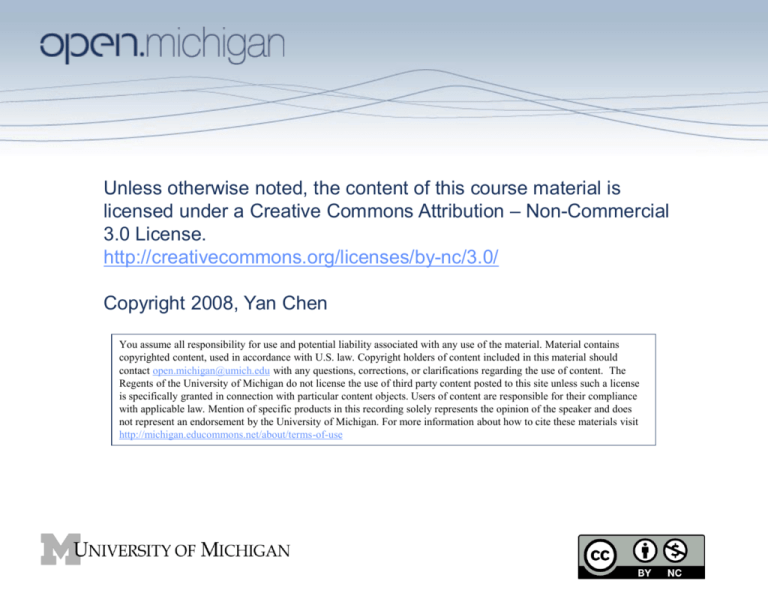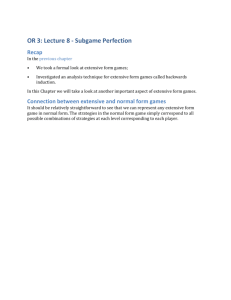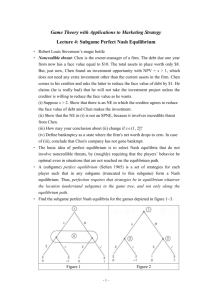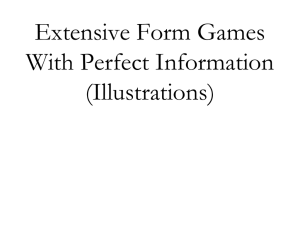SI563-F08-week3 - Open.Michigan
advertisement

Unless otherwise noted, the content of this course material is licensed under a Creative Commons Attribution – Non-Commercial 3.0 License. http://creativecommons.org/licenses/by-nc/3.0/ Copyright 2008, Yan Chen You assume all responsibility for use and potential liability associated with any use of the material. Material contains copyrighted content, used in accordance with U.S. law. Copyright holders of content included in this material should contact open.michigan@umich.edu with any questions, corrections, or clarifications regarding the use of content. The Regents of the University of Michigan do not license the use of third party content posted to this site unless such a license is specifically granted in connection with particular content objects. Users of content are responsible for their compliance with applicable law. Mention of specific products in this recording solely represents the opinion of the speaker and does not represent an endorsement by the University of Michigan. For more information about how to cite these materials visit http://michigan.educommons.net/about/terms-of-use 1 SI 563 Lecture 3 Solving Extensive Form Games: SPNE Professor Yan Chen Fall 2008 Some material in this lecture drawn from http://gametheory.net/lectures/level.pl 2 Agenda – Backward induction (First Half) – Subgame perfection (Second Half) 3 Solving Extensive-Form Games Look Forward, Reason Back (Watson Chapter 14, 15) 4 Comparison of Normal and Extensive Forms • An extensive form can be translated into a normal form • Normal-form concepts are valid for every game • Nash equilibrium is still a valid solution concept for an extensive form • In some games, the extensive form most precisely captures the order of moves and the information structure 5 Example: Entry and predation. 1 Out 0, 4 Accommodate 2 2, 2 In Price war -1, -1 Player 1: potential entrant Player 2: incumbent 6 Example: Normal Form for the Entry and Predation Game 2 1 A P I 2,2 -1,-1 O 0,4 0,4 Two pure strategy Nash equilibria: (I, A) and (O, P) However, (O, P) is not plausible. Note: if eliminate weakly dominated strategy, problem! 7 Sequential Rationality • An optimal strategy for a player should maximize his or her expected payoff, conditional on every information set at which this player has the move • Player i’s strategy should specify an optimal action from each of player i’s information sets, even those that player i does not believe (ex ante) will be reached in the game 8 Backward Induction • If sequential rationality is common knowledge, each player should look ahead to consider what others will do in the future in response to her move at a particular information set • Backward induction: the process of analyzing a game from back to front (from information sets at the end of the tree to those at the beginning). At each information set, strike out actions that are dominated, given the terminal nodes that can be reached. 9 Example: Charlie Brown vs. Lucy Lucy’s preference (best to worst): CB falls down Nothing happens CB kicks the ball Charlie Brown’s preferences: opposite Diagram courtesy: Dr. Tayfun Sönmez 10 Example: Backward induction 1, 4 A 2 U 5, 2 B 1 1 D 2 E 3, 3 F 2, 0 C D 6, 2 A single sequentially rational strategy profile: (DE, AC), check that this is also a Nash equilibrium 11 Example: Voting for a Payraise Three legislators are voting on whether to give themselves a pay raise. All three want the pay raise; however, Each face a small cost in voter resentment c>0. The benefit for the raise is greater than cost: b>c They vote in the order 1-2-3. Simple majority rule What is the outcome obtained by backward induction? (N; NY; nyyn) Diagram courtesy: Dr. Tayfun Sönmez 12 Advertising and Entry • An established retailer is facing possible competition from a rival • The established retailer can try to stave off entry by engaging in a costly advertising and price cutting campaign Source: John Morgan, gametheory.net 13 Speed and Flexibility • The rival is fast and flexible, so its policy is to wait and decide at the last possible instant its entry choice • Thus, the rival observes the initiation of this campaign before making its entry decision Source: John Morgan, gametheory.net 14 Strategies and Payoffs • Incumbent: Advertise or not • Rival: Enter or not Source: John Morgan, gametheory.net 15 Payoffs: • Incumbent (Best to worst) – No entry and no ads – No entry and ads – Entry and no ads – Entry and ads • Rival – Entry and no ads – No entry and ads – No entry and no ads – Entry and ads Source: John Morgan, gametheory.net 16 Game Tree In 1, 1 R Ads 3, 3 Out I In No ads R Out Source: John Morgan, gametheory.net 2, 4 4, 2 17 Equilibrium Prediction • The prediction from this model is that the incumbent will run its ad campaign and this will effectively forestall entry • Notice that even in absence of actual entry, the potential competition from the rival eats into the incumbent’s profits. Source: John Morgan, gametheory.net 18 Is Flexibility an Advantage? • Suppose that the rival is less flexible in its management practices. • It must commit to enter or not before the advertising decision of the incumbent. • How does this affect the outcome of the game? Source: John Morgan, gametheory.net 19 Game Tree – Stodgy Rival Ads 1,1 I In 4, 2 No ads R Ads Out I No ads Source: John Morgan, gametheory.net 3,3 2, 4 20 Equilibrium Prediction • Notice that now the prediction is that the rival will enter and the incumbent will not advertise • The absence of flexibility on the part of the rival improves its outcome relative to the case where it retained flexibility. • This game has a first-mover advantage Source: John Morgan, gametheory.net 21 Do all games exhibit first-mover advantage? • No • Procurement contracts: – Two firms are bidding for a procurement contract, which will be awarded to the low bidder. – There is a cost to preparing a bid – Firm 1 chooses its bid followed by firm 2. – Clearly it pays to go second and undercut the bid of the first firm Source: John Morgan, gametheory.net 22 Location Decisions • Three retailers (A, B, and C) are deciding their location decisions for an emerging metropolitan area • Their decision is whether to locate in an urban mall or a suburban mall • The urban mall has spots for 2 stores • The suburban mall has spots for all 3. Source: John Morgan, gametheory.net 23 Motivation • The urban mall has more traffic than the suburban mall • There are synergies in mall location – The presence of 2 or more large stores drives disproportionate traffic to that mall Source: John Morgan, gametheory.net 24 Strategies and Payoffs • Each retailer chooses where to locate: urban or suburban • Payoffs (Best to worst) –Urban mall with other stores –Suburban mall with other stores –Urban mall alone –Suburban mall alone –No mall Source: John Morgan, gametheory.net 25 Mall Allocation • The malls are not strategic players. • Urban: B and C have priority over A • Suburban: Accept anyone Source: John Morgan, gametheory.net 26 Timing • Firm A moves first, followed by B, and then C Source: John Morgan, gametheory.net 27 Game Tree U 1,5,5 C U S U B U C S 5,5,2 5,2,5 3,4,4 S U A 2,5,5 C U S 4,3,4 S B U 4,4,3 S 4,4,4 C S Source: John Morgan, gametheory.net 28 Equilibrium Prediction • Firm C chooses suburban only if other 2 choose S • Firm B knows that by choosing an urban location, C will follow suit, therefore it goes urban • Firm A knows that B will go urban regardless and that C will follow B’s lead, therefore if it goes urban, it will be shut out – Therefore A goes suburban and ends up alone Source: John Morgan, gametheory.net 29 General Principles • Sketch a game tree outlining who moves when • Construct a ranking of outcomes for both you and your rivals. • Look forward and reason back • If the outcome is not a desirable one, think about how you might change the game 30 Ways to Change the Game • Contracting: Look ahead in thinking about the strategic implications of contract terms • Change the order of moves (i.e. commitment) to gain a first-mover advantage. 31 Potential Problems with Backward Induction: 3-Level Centipede What is the outcome obtained by backward induction? What are the Pareto efficient outcomes? What do people actually do when they play the centipede game? McKelvey and Palfrey (1992) Econometrica Diagram courtesy: Dr. Tayfun Sönmez 32 Another Problem with Backward Induction Diagram courtesy: Dr. Tayfun Sönmez 33 Solving Extensive-Form Games Subgame Perfect Nash Equilibrium (Watson Chapter 15) 34 Subgame and Proper Subgame • Given an extensive-form game, a node x in the tree is said to initiate a subgame if neither x (nor any of its successors) are in an information set that contains nodes that are not successors of x • A subgame is the tree structure defined by such a node x and its successors • Subgames that start from nodes other than the initial node are called proper subgames 35 Example: Subgames 1 2 x B 3 2 1,5,7 H 7,7,2 G 0,6,1 H 8,6,0 2,0,3 w C D F G z 1 D 3,3,6 y A U E 6,2,4 How many subgames does the game tree have? 36 Subgame Perfect Nash Equilibrium • An extension of backward induction • A strategy profile is a SPNE if – It is a NE, and – For every subgame, the restriction of those strategies to the subgame is also a NE • A solution concept should be consistent with its own application from anywhere in the game where it can be applied 37 Finding SPNE • Finding SPNE is similar to backward induction – Start from the subgames which start with a node closest to a terminal node – Find NE of the subgame – Replace the subgame with the NE payoffs and work backwards – If there are more than one NE of the subgame, repeat this for each subgame 38 Example 1 • What are the NE and SPNE of this game? Diagrams courtesy: Dr. Tayfun Sönmez • Two NE: (D, R) and (U, L) • How many proper subgames? • Consider the proper subgame: the unique NE of the subgame is R. Therefore, (U; L) is not a SPNE • Hence (D; R) is the only SPNE • Note SPNE coincides with the outcome obtained from backward induction 39 Example 2: Subgame perfection 2 X 3,4 Y 1,4 X 2,1 Y 2,0 A 1 U B 1 D 2,6 How many subgame and proper subgames does this game have? 40 Example 2: Normal Form of the Entire Game: 2 1 X Y UA 3,4 1,4 UB 2,1 2,0 DA 2,6 2,6 DB 2,6 2,6 3 pure strategy NE: (UA, X), (DA, Y) and (DB, Y) 41 Example 2: Normal Form of the Proper Subgame: 2 1 X Y A 3,4 1,4 B 2,1 2,0 One pure strategy NE: (A, X). The only SPNE for the game is (UA, X). 42 Example 3. Price War • NE: (NH; H) and (NL; H) • How many proper subgames? • Which of the NE are subgame perfect? Diagrams courtesy: Dr. Tayfun Sönmez – Unique NE of subgame is (H; H) – Since (L; H) is not a NE of the subgame, (NL; H) is not a SPNE – The only SPNE is (NH; H) 43 Example 4: Multiple SPNE • 1st subgame • Two NE: – (u; L) yielding (4, 2) – (d; R) yielding (1, 2) Diagrams courtesy: Dr. Tayfun Sönmez 44 Example 4: Multiple SPNE • Case 1: replacing subgame with payoff from (u; L) • First SPNE: (Du; L) yielding (4, 2) Diagrams courtesy: Dr. Tayfun Sönmez • Case 2: replacing subgame with payoff from (d, R) • Second SPNE: (Ud; R) yielding (2, 1) 45 Example 5 • 2 proper subgames • 1st subgame: 1-person decision problem. NE yields (2, 2, 2) • 2nd subgame yields two NE Diagrams courtesy: Dr. Tayfun Sönmez 46 Example 5: 3 SPNE • Case 1 SPNE: (WU; L; AX) yields (2, 2, 2) (DW; R; AX) yields (4, 2, 1) • Case 2: SPNE: (UZ; L; AY) yields (2, 2, 2) Diagrams courtesy: Dr. Tayfun Sönmez 47 King Solomon’s Dilemma • Two women claim a baby • Each knows who the true mother is • King Solomon may assign the baby to one, or to neither, and may also impose fines on them, m1, m2 • Woman i’s payoff is – Vh-mi if she is the true mother – Vl-mi otherwise where Vh > Vl > 0 48 King Solomon’s Dilemma: an ICD Solution • 1 is asked if the baby is hers – If 1 says no, baby is given to woman 2 and no fine is imposed – If 1 says yes, woman 2 is asked if 2 is the mother » If 2 says no, baby is given to 1 and no fine is imposed » If 2 says yes, 2 gets the baby and • 2 pays a fine of M, where Vh > M > Vl • 1 pays a small fine f > 0 • What’s the SPNE? 49 Summary: SPNE • A SPNE is a Nash equilibrium – A refinement of NE • For games of perfect information, backward induction yields SPNE • The procedure we described is usually the best procedure for finite games 50 Homework Assignment • Chapter 15: #1, 2, 3, 5 51







